#Mechanized infantry
Explore tagged Tumblr posts
Text
Point Zulu X-ray Charlie, Position Quebec Foxtrot Golf.
</>DOEas anyObe copy!? Overk?!#)+kj</>
</>tHdzis ihYntz Xia-3-2! Half of our pErtzyohnelle hrre are dead! Requesting innediate Sa asstz atzossoistzahntzhynvithviyhn#;;#--<! How cokopu,iyhn, over?!</>
</>doEs any notheRfvuckhyingh persontzelhynviyhn on tdzisz nyhent kopiy!?</>
</>vEre veing being overrun! We need help hyelpnn nauw!3¡!!!</>
#Overrun#Xiao-3-2#xanxon#unreal#unreality#xanxoni#Battle#Mechanized infantry#Position#Point#Assassinatiyorhhyn#Rasio#A radjiyohn radjiyouh hehyn viyhn rassiyouhn rassiyo v hehyn xiao juliyrttah vvh v hehyn
3 notes
·
View notes
Text
Book 42 of 2024 (★★★)

Title: Heavy Metal: Memoir of a distant war Authors: Edward Roby
ISBN: 9783347130500 Rating: ★★★ Subject: Books.Military.20th-21st Century.Asia.Vietnam War.Armor
Description: This is the story of an armored infantry company in action north of Saigon during the phase the Vietnam War spanning the Tet offensive. The narrative unfolds from the vantage point of a young infantry captain who commanded Company C, Second Battalion, Second Infantry Regiment in the First Infantry Division from late September 1967 through the end of April 1968. 'Heavy Metal' spotlights the central role of armored vehicles as fast-moving gun platforms in the deployment of his mechanized infantry soldiers. Apart from combat actions, the book describes a soldier's everyday life in fortified field positions, the defense of the division's forward base at Lai Khe, the company's decimating outbreak of falciparum malaria and the inevitable accidents with explosive ordinance. This is the story of an armored infantry company in action north of Saigon during the phase the Vietnam War spanning the Tet offensive. The narrative unfolds from the vantage point of a young infantry captain who commanded Company C, Second Battalion, Second Infantry Regiment in the First Infantry Division from late September 1967 through the end of April 1968. 'Heavy Metal' spotlights the central role of armored vehicles as fast-moving gun platforms in the deployment of his mechanized infantry soldiers. Apart from combat actions, the book describes a soldier's everyday life in fortified field positions, the defense of the division's forward base at Lai Khe, the company's decimating outbreak of falciparum malaria and the inevitable accidents with explosive ordinance.
My Review: Meh… nothing really happens, nothing is really gained by this book except to learn more about how NDP's are set up and the famous Hay's Holes.
#Book#Books#Ebook#Ebooks#Booklr#Bookblr#History#Military History#NonFiction#War#Vietnam War#Mechanized Infantry#mech infantry#US Army#1st infantry division#Lai Khe
0 notes
Text

Ukrainian infantry soldiers of the 23rd Mechanized Brigade, Avdiivka, Donetsk region, Ukraine, 2024 - by Roman Pilipey, Ukrainian
67 notes
·
View notes
Text
my caves of qud character getting gender euphoria from opening their sheet and seeing chrome "hardpoint" equip slots
#its so fun how u can start thee game as a human#and by mid-late game b something more akin 2 a mechanized infantry vehicle
7 notes
·
View notes
Text
how do i always forget how hard GPTvsTMK goes. unbeatable
20 notes
·
View notes
Text
so far getting into the mechanisms has had the devastating effect of me having to explain to my mother that the lines "they're booooiling us, they're booooiling us-" have been playing in my head nonstop for the past three days
#the CONCERN on her face#genuinely i'll be whistling to myself and then i'm like oh god the kaiser wants to microwave the british infantry#the mechanisms#tales to be told
10 notes
·
View notes
Link
The article "Japanese Type 100 Submachine Gun — Too Few and Too Late," authored by Tom Laemlein, explores the Japanese Type 100 submachine gun and its delayed production during World War II. The article details Japan's initial lack of interest in submachine guns during the 1930s, and how, despite eventually manufacturing the Type 100 in 1944, they missed the opportunity to effectively compete with other nations' short-range firepower. The article traces the history of submachine guns, highlighting the influence of the .45 caliber Thompson and European models, the development of a simplified Bergmann-type submachine gun by Japan, and the evolution of the Type 100 through various models such as the paratrooper version with a folding stock. Despite efforts to update and improve the gun, it was ultimately limited by production constraints and the underpowered 8x22mm Nambu round. The Type 100 remains a historically interesting weapon but was not on par with other submachine guns of World War II.
#Japanese Type 100 submachine gun#World War II#Imperial Japanese Army#firearm design#submachine guns#military weapons#Kenjiro Nambu#semi-automatic fire#Nambu Type 14 pistol#8x22mm Nambu cartridge#lighter#shorter barrel#T100 magazine#bolt mechanism#Japanese infantry#Type 100/40 model#late-war Type 100/44#paratroopers#muzzle brake#fixed stock design#Japanese military history#weapon manufacturing#Tokyo Arsenal#ordnance.
0 notes
Text
Civ, what do you Mean I lose???? I play for Ten Hours and come within 3 turns of science victory and all I get is, "You lose, next!"
Fucks ache.
#i hate sid meier i wanna blast him into space without a spacesuit (affectionate)#my boy trajan gonna mechanized infantry him back to the classical era
0 notes
Text
TOTAL BATTLE LOGİN - PRO+
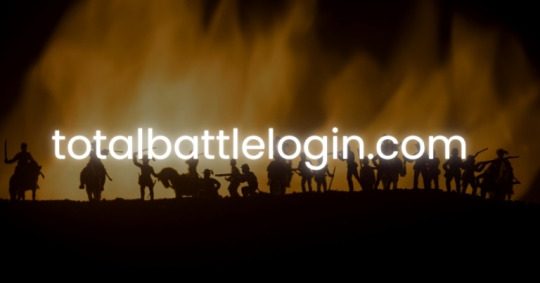
Welcome to the ultimate gaming experience with Total Battle, a strategic online war game that challenges your tactical skills while immersing you in a captivating medieval world. In this article, we’ll explore the essentials that every player needs to know, including how to navigate the Total Battle login process, maximize your gameplay, and delve into comprehensive guides that will elevate your strategies. Whether you're a seasoned general or just starting your journey, you’ll find valuable insights and tips to help you conquer your foes and build a formidable empire.
Total Battle Login
Accessing your gaming experience has never been easier with the total battle login. This streamlined process allows players to quickly enter the highly immersive world of Total Battle, ensuring that your journey toward strategy and conquest begins without delay.
Once you reach the total battle login page, you'll find an intuitive interface designed to facilitate your entrance. Whether you're a seasoned commander or a new recruit, you can swiftly log in using your credentials and pick up right where you left off in your quest for dominance.
In addition to great accessibility, the total battle login ensures your data protection and provides a seamless connection across devices. This means you can enjoy your favorite strategies on-the-go, enhancing your gaming flexibility and freedom.
Don't let obstacles stand in your way! Experience the thrill of Total Battle with a fast, reliable login process. Explore the possibilities at your fingertips – dive into engaging gameplay today with the total battle login!
Total Battle
Total Battle offers an immersive gaming experience that combines strategic warfare with resource management, making it a go-to choice for gamers looking for depth and excitement. The focal point of the game revolves around building your empire, forming alliances, and engaging in epic battles. Players can expect to dive into various gameplay modes designed to enhance their strategic skills and test their tactical abilities.
One of the significant advantages of total battle is its comprehensive total battle guide that aids both new and experienced players. This guide provides players with vital information on unit formations, resource allocation, and battle tactics, ensuring that you always stay one step ahead of your opponents. With regular updates and community contributions, this guide evolves alongside the game, maintaining its relevance and usefulness.
When you visit totalbattle, you are welcomed with a user-friendly interface that simplifies the login process, allowing you to jump straight into action. The platform is designed to be intuitive, making it easy for players of all skill levels to navigate and find helpful tools and resources that enhance their gameplay experience.
Join a thriving community of players who engage in strategic discussions, share their experiences, and dominate the battlefield. With Total Battle's dynamic gameplay and community-driven atmosphere, you will not just be a player— you will become part of a unified force aimed at conquering new territories and achieving glorious victories.
Total Battle Guide
Welcome to your ultimate total battle guide, designed to help you navigate through the exciting world of Total Battle efficiently. Whether you are a newcomer seeking to understand the basics or a seasoned player looking for advanced strategies, this comprehensive guide is here to enhance your gameplay experience.
Understanding Game Mechanics
Total Battle combines elements of strategy, city-building, and warfare. Familiarize yourself with the core mechanics to maximize your success:
Resource Management: Balance your resources like gold, wood, and food to ensure steady growth of your empire.
Unit Types: Learn about the various units available, including infantry, cavalry, and siege equipment, and understand their strengths and weaknesses.
Buildings: Upgrade your city by constructing essential buildings that boost your economic and military might.
Strategic Gameplay Tips
To gain an edge over your opponents, implement these tips into your strategy:
Scout Before Attacking: Always scout enemy positions to make informed decisions before launching an attack.
Join an Alliance: Collaborating with other players provides support and enhances your strategic options.
Daily Login Rewards: Make sure to log in daily to claim valuable rewards that will assist you in your quest.
Explore Tactical Features
The game offers various tactical features to gain dominance over your rivals. Mastering these can lead to significant advantages:
Hero Development: Develop your heroes by equipping them with powerful gear and leveling them up for enhanced abilities.
Battle Tactics: Experiment with different formations and tactics to find the best approach during battles.
Event Participation: Engage in special events that often yield unique rewards and opportunities for bonuses.
Utilizing this total battle guide will empower you as you embark on your journey in Total Battle. For further assistance or in-depth lore, don’t forget to check out TotalBattleLogin.com. Start your adventure today and conquer your foes with confidence!
Totalbattle
Discover the captivating world of Totalbattle, where strategy and action collide! Immerse yourself in the exhilarating gameplay designed to challenge even the most seasoned gamers. From building your powerful empire to forging alliances with other players, the Total Battle experience is ever-evolving and engaging.
The game seamlessly blends elements of classic strategy with modern features, ensuring that every session is unique. Whether you are a newbie or a veteran, the Total Battle guide is your essential tool for mastering gameplay tactics and optimizing your journey.
Accessing the game through the Total Battle login portal opens doors to exclusive events, rewards, and updates that keep the excitement alive. Enhance your gameplay experience by diving into rich lore and strategic warfare mechanics that Total Battle has to offer.
Join a vibrant community of players who share tips, strategies, and camaraderie in their quest for dominance. Don’t miss out on the opportunity to enhance your skills and achieve greatness. Take the first step by visiting Total Battle and preparing yourself for an epic adventure!
1K notes
·
View notes
Note
If I could ask you for some advice, what do you think helps the flavour text of a mech or piece of equipment sell a player on the fantasy of using it?
I'm finding it frustratingly difficult to do so with my own homebrew content: I can come up with lore and backstory easily enough, but re-reading it feels dry, and I can't help but contrast it with how the descrptions in official content and other supplements is more evocative, at least for mechs.
Let's observe some corebook Lancer flavour text and examine the various varieties it comes in.
Purely Functional

While it's usually not the most fun type of flavour text, this just tells us what the weapon is, and - if it has any particular tags or on-hit effects - why it's like that. The Hand Cannon is a good example: here's what it is (modified pistol), here's why it does more damage, and here's why it has Loading.
The main advantage of Purely Functional flavour text is that it provides space for other types of flavour text to breathe. Flavour text is a great place for jokes, but it's not good for every piece of flavour text to be a joke - the pauses between notes in music are just as important as the notes.
Obfuscating Vendorspeak
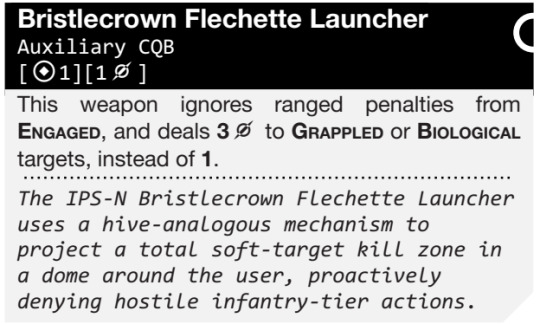
The Bristlecrown Flechette Launcher this is a great example of dark humour that Lancer uses quite often: marketing fast-talk to cover up something really unpleasant. The joke here is based on us understanding precisely what the equipment does mechanically, and then seeing how the manufacturer tries to sell it. There's a bunch of dense technobabble here meant to obfuscate the fact that this weapon fires knives in every direction specifically designed to kill infantry.
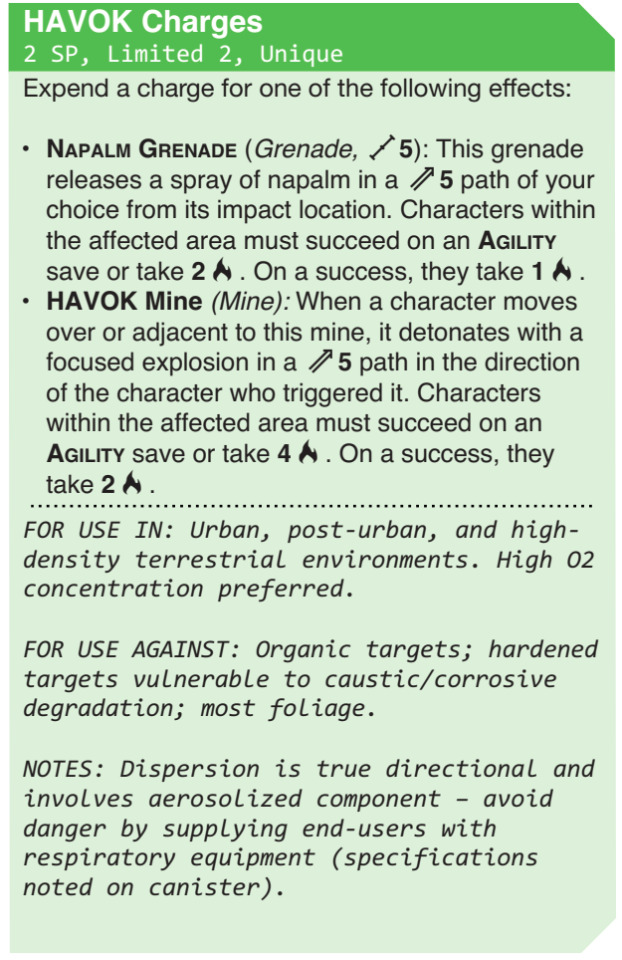
Deadpan Weirdness

The joke here relies on describing something extremely weird like it's the most natural thing in the world. Wait, you're telling me that in a world where I can just print new parts if the old ones break, they put DRM on my fucking knife and I have to apologise to the fucking knife maker to get a new one? What the fuck, dude? Why are you acting like this makes any sense?!

My sword uploads fucking what to the Space Internet?!
Third-Act Twist
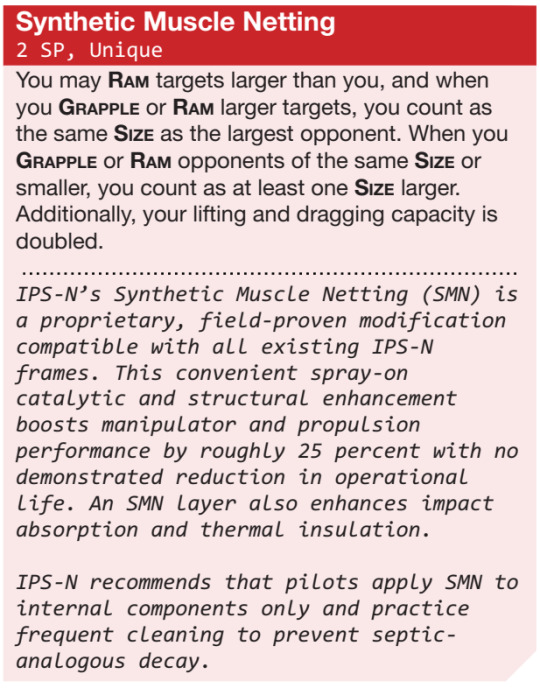
This type of flavour text disguises itself as something else - most often Purely Functional - and then hits you with Third Act Twist. It makes you go "wait, what?!" It's very classic setup-punchline stuff. You're telling me my mech can rot?!
As a side note, Lancer loves to use this for its NHPs.

WHY DID YOU PUT THAT IN SCARE QUOTES, LUCIFER
Worldbuilding
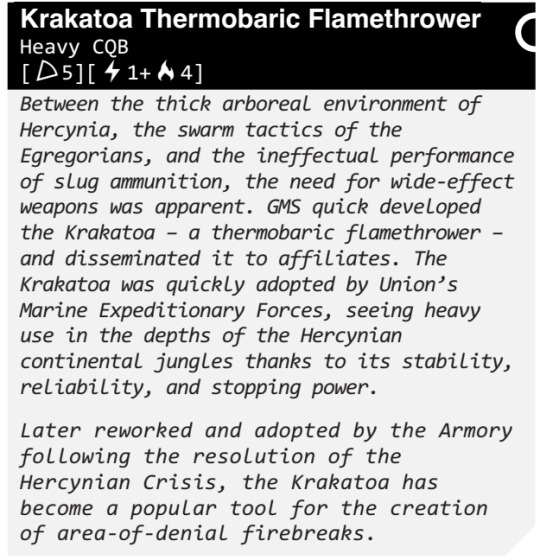
This is similar to the Purely Functional, but instead of just describing technical specifications of the weapons, it puts the weapon in the broader context of the setting's history. Okay, so we know what this weapon is and what it does - why was it built? What was the original use case, and why? Most importantly, what can the existence of this weapon tell us about the world that build it?

Whimsical Aside
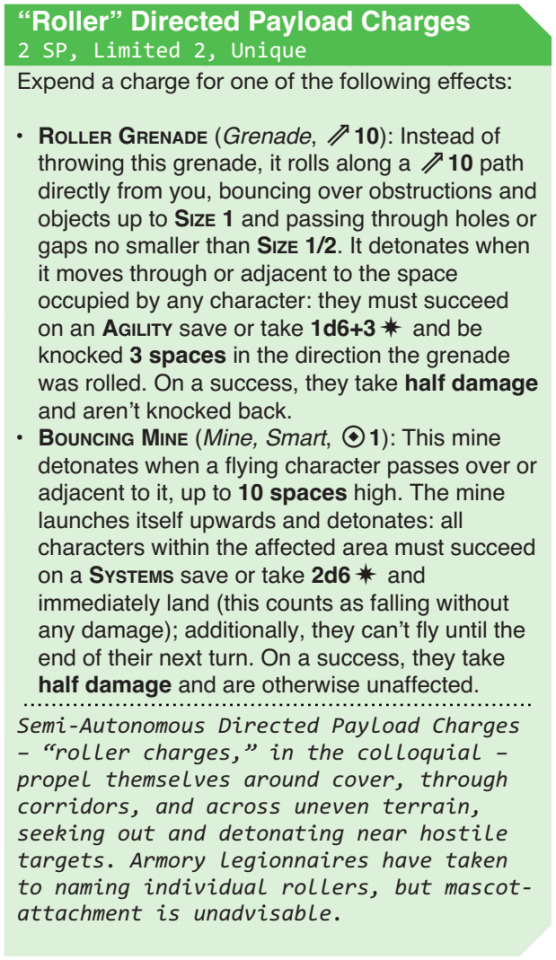
This is the insertion of a light-hearted, humanising little insertion regarding how this piece of equipment gets used in the field. This serves to remind us that soldiers aren't cold, unfeeling killing machines: they can be as emotional, irreverent and silly as the rest of us, and they do things like name their mobile bombs...
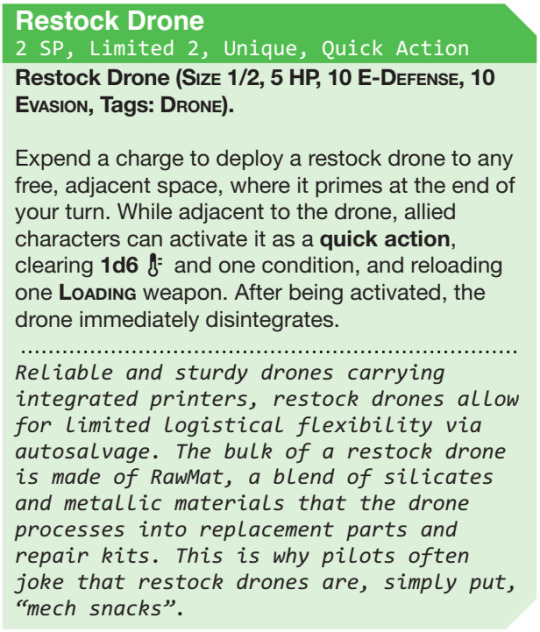
... or call resupply drones "mech snacks."
The Ominous Out-Of-Context Quote That Explains Nothing And Only Raises More Questions

As I've said in multiple textmash memes, this is basically Tom and Miguel's shorthand for "this technology is Intensely Fucked Up in a way that it is more fun and scary not to explain." This is essentially Lancer's version of SCP's [REDACTED].
You might think this is the domain of HORUS, and you'd be right, but every single manufacturer indulges in these - although IPS-N had to wait until NRFaW to get theirs:
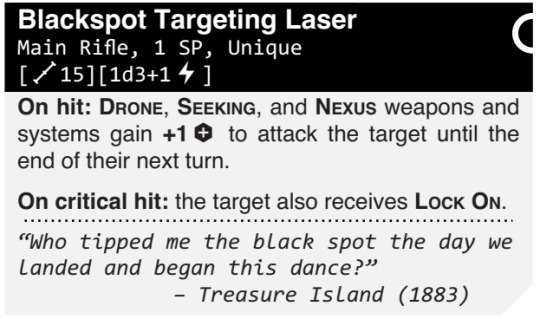
What the fuck do you mean by that, Lancer?
621 notes
·
View notes
Text

Mechanized Urban Infantry
585 notes
·
View notes
Text
Book 36 of 2024 (★★★)

Title: The Platoon Commander Authors: John O’Halloran
ISBN: 9780733647475 Rating: ★★★ Subject: Books.Military.20th-21st Century.Asia.Vietnam War.Australia
Description: John O'Halloran was a country boy from Tamworth, NSW, who was called up for national service not long after the start of the Vietnam War. As a tough and determined 21-year-old, he guided 6 RAR's B Company 5 Platoon through some of the biggest conflicts of the war, including Operation Hobart and the Battle of Long Tan. But he faced his hardest military challenge at Operation Bribie, leading a fixed bayonet charge against a deadly Viet Cong jungle stronghold. The Platoon Commander is an unmissable and devastating first-hand account of the realities and brutalities of war, and especially this war fought in jungles, not trenches, which would go on to bitterly divide Australians. O'Halloran's sense of duty and strong character carried him and his men through fierce battles and uncertainty. His sense of humour kept him going through the years afterwards. His indomitable spirit inspired the men of 5 Platoon to fight against the odds to achieve the mission - no matter how treacherous - and even away from the action and in the many years since O'Halloran kept the respect of his men. Now regarded by many of his peers as a national treasure, John Patrick Joseph O'Halloran has been quoted in almost every important book written about Australia's involvement in the Vietnam War, yet has never told his own remarkable story. Until now.
#Book#Books#Ebook#Ebooks#Booklr#Bookblr#History#Military History#NonFiction#War#Vietnam War#Australian Army#Nui Dat#Mechanized Infantry#Battle of Long Tan
0 notes
Text
A fun thing I noticed about Flying Circus and its Chariots of Steel expansion is that in both systems combat is extremely isolating, but they isolate in opposite ways.
Combat in Flying Circus is agoraphobic (or more accurately it is kenophobic). You might be part of a team, but you are alone in a vast blue void. It's so big that getting lost in a clear sky is a genuine possibility. Things appear as if from nowhere and disappear the moment you take your eyes off them. Someone who was in your gun sights one minute might be on your tail the next, and you have no idea how they got there. Even if you are lucky enough to have a backseater, you can't really talk to them unless you shell out for an intercom. Unless everyone installs expensive and bulky radio equipment you can't talk to the rest of your team either. If things go far enough off script you can literally go down in flames and your friends won't know until they find your smoking crater...if they ever do.
In contrast, Chariots of Steel is claustrophobic. If you are a tanker, you are stuck in a cramped metal box. You can't hear anything over the engine, and you can barely see anything out of the tiny vision slits. Sure you have crew, but unless you pay extra for an intercom your only means of talking with your crew will be strategic kicks. Infantry have it just as bad. Soldiers in the open are better known as "target practice", so you'll spend a lot of time huddled behind stuff with your head down, praying that there isn't someone sneaking closer with a grenade. This status quo of blind terror is enforced through the Suppression and Morale mechanics, which are critical to how fights work in CoS.
The extent of this isolation is obviously going to vary based on the tone of your game, but it's baked into the rules of both systems. Even figuring out where people are and what is going on usually requires a roll, and communication is complex and crude unless you jump through a lot of hoops. Teamwork is still possible and often key to success, but this isn't D&D where everything is laid out neatly on a grid and talking is a free action. When the bullets start flying it's just you and your instrument-shaped character sheet. You can't focus on the entire battle, just your little corner of it.
It's a truly unique approach, and I really like it.
217 notes
·
View notes
Text
The more we know about Garak the more ridiculous some of his lies seem in retrospect. I was a gul in the Cardassian mechanized infantry - no the fuck you were not
420 notes
·
View notes
Text
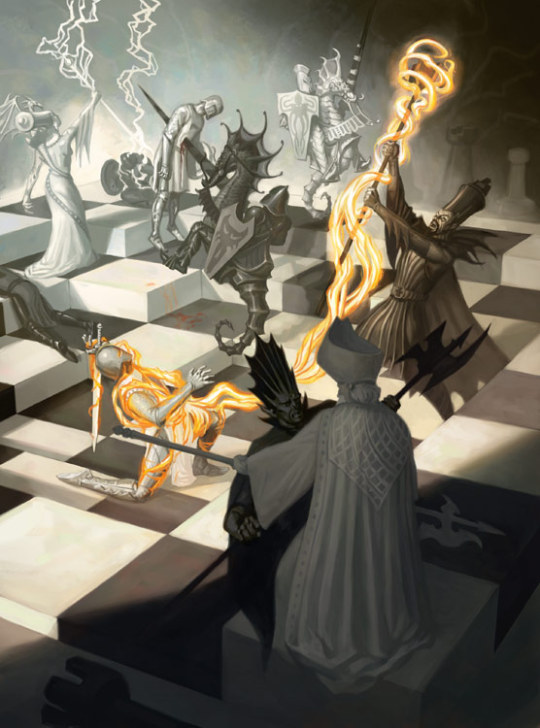
DM Tip: Lining up the Pieces
A few years ago I saw a video that changed the way I design combat encounters, using chess pieces and 4th edition monster roles as a handy way of conceptualizing the enemy roster and making better combat.
I’ve wanted to refer back to it for ages now, but I can’t seem to find it. As such, I’m going to reproduce it’s wisdom here for everyone’s benefit and hope I can find the source one day. ( I feel like it was a Matt Coville video, but my searches have turned up nothing. Seriously, if you can find it I will be extra grateful).
TLDR: You can break down enemy combatants into six (ish) roles represented by different kinds of chess pieces, and you can mix and match them when designing encounter to create fun tactical scenarios. You can also use this as an alternative to CR picking a “budget” of these enemy roles based on how many players are in the fight. Check out the types below the cut:
Infantry (pawn): Generally weaker and mechanically simpler than any other type of combatant, the infantry uses teamwork or sheer numbers to overwhelm the party. This can be anything from rank and file soldiers to a necromancer’s skeletal minions to a pack of wolves, anything that takes up space on the battlefield and prevents the party from targeting who they want or generally getting their way in a fight. 5e combat is a numbers game, and the infantry is there to swing the numbers in the enemy’s favour (until the party cut through them to even the odds). Infantry likes battlemaps with chokepoints they can hold and crossroads they can use to outflank opponents. When budgeting they’ll have a balance of 2 infantry per 1 player they’re matched against , but the weaker they are, the thinner you can spread them.
Brute (rook): High defence, high offence, the brute is an outright threat that the party should not want to take in a head to head fight. Giants, beasts, constructs, and heavy armoured warriors are your traditional brutes, but you could also go with a buffed to hell battlemage getting all up in the party’s face. Conversely, every brute has some kind of weakness that the party can exploit. They might be slow, or be unable to maneuver as easily, or like a werewolf, fiend, or troll, have particular weapons or damage types that overcome their natural resilience. Their job is to force confrontation, blunder into the middle of combat and force the party to act defensively rather than proactively. They soak up the party’s frontline’s attention while forcing the mid/backlines to scatter under the threat of too much raw damage. The brute Likes open spaces where they can have a direct path to the party and dead ends they can corner their targets against. Budget: Around 1 per 3 players
Skirmisher (knight): A very broad type of opponent, the skirmisher’s job is to bully the party’s weapsots whenever they’re exposed. They can do this by being ranged fighters ( traditional archers, magic users) or by being highly mobile (stealthy, mounted, flying, teleporting). They’re the bane of the party’s backline, generally targeting whoever has the lowest armour/or least health, then using their evasiveness to deny any kind of retaliation when the group rallies to protect their squishy friends. Skirmishers have great offence but are generally pretty weak, made helpless when you can deny them their movement/terrain advantages. Skirmishers like unfair fights, terrain that gives them a movement advantage, cover, or allows them the highground over their foes. Budgeting: 1 per 1-2 players.
Controller (bishop): The controller’s job is to fuck with the party, Either by locking down some of their stronger options (counterspelling, mind control, status effects, grapples), by manipulating the battlefield in some way that disrupts planning (aoe spells to prevent grouping together, summoning to reinforce numbers, barriers and banishment to single targets out), Or by advancing the baddies’ goal while the party is otherwise occupied (the cult priest finishing the disastrous ritual, the master thief making off with the mcguffin) forcing them to split their attention. The controller likes to distinctly be away from combat, and will usually be on the otherside of some kind of hazardous/hard to bypass barrier, sometimes of their own making. Budgeting: 1 per 2-3 players:
Support (king): Usually a healer, bodyguard, or some kind of buff-bot, the support wants to piggyback on other sorts of units or make them better at doing their jobs. Generally this means they’ll ignore whatever the party is doing to focus on staying with effective range of those who most benefit from their abilities. Supports will stay back in safety while throwing out buffs, bodyguards will put themselves between the party and their designated defendee. They tend to prefer whatever type of terrain most benefits their partners. 1- 2-3 players
Elite (queen): Something to be reckoned with, an Elite mixies the strength and abilities of two other kinds of combatants and uses both to devastating effect. Combine a brute and a support for an unstoppable frontline commander, or infantry and a skirmisher for an elite striketeam that attacks in perfect coordination before fading back into the shadows. Mix and match for whatever combination you think would be most interesting for a situation, then supplement it with a different unit or two for contrast. Elites make up your traditional “big bad and minions” bossfight, without escalating to the full party challenge of “solo” monsters. Budgeting: 1 per 3-4 players.
Picking the right Pieces:
Generally what you're going to want to do when planning a combat is to first think of what the baddies are trying to acomplish with the fight then pick 2-3 different types of baddie that you think would work well in concert to achieve that goal. "Kill the party" is an all too common goal, but you could easily imagine others that provide for dynamic stakes:
A group of forest bandits intend to rob a caravan, so they unleash a captive warbeast as a distraction while their archers rain chaos from above (Infantry, brute, skirmisher)
A villain abducts an important npc into a carriage while their dutiful muscle run interference (controller, brutes)
A necromancer hurls curses from behind a barricade of gravestones while their undead minions pour from surrounding tombs ( Controller/infantry)
While the party is ambushed by an archer in a tower, a cloaked figure waits in the underbrush, waiting for them to thin out and begin picking them off one by one (paired skirmishers of different types)
After the fighter is tricked into single combat against the mounted arena champion, the rest of the party will have to search the crowd for the caster secretly channeling healing magic to their opponent. ( combined brute/skirmisher elite, support)
Once you've got your pieces picked out, you can start designing the battle arena taking the desires of each combatant into account while also throwing in any environmental flourishes you'd like to enjoy.
As an added benefit for DMs like me who don't have the inclination or budget to collect huge batches of minis, it's SUPER easy to pick up a second hand chess set or two and use them as stand ins. Your players will have an instinctive understanding of what each piece does which will help them understand the roles outlined above.
Artsource
472 notes
·
View notes
Text
Mechposting? Nah. Armorposting. Wearing a suit of form-fitting power armor, functional, utilitarian, perfect for a singular object of precise destruction. Utterly modular, the suit is a second skin. They come home, drenched in blood, not heightened on stims, but simply the mad rush of close combat, atomizing enemies with a rush down of missile swarms.
A handler cracks the suit open, pulling the soldier from their exo-armor—and simply listens. They don’t have the same luxury of mech pilots being on stims. They cannot, for the mech is a twenty-feet tall machine for mass killing, while the exo-armor is personal. intimate. They lead the infantry, they do grav-jumps from hovertanks, they go where mechs cannot, idolized knights of steel and fiber in their shells—they must see all, hear all, and in the end they are relegated to the same space as the mech pilot—clinging to their handler, begging for a light kiss on the cheek, a written excuse to spend the day clinging together in a too-small cot, pictures and gifts dangling off the inside of the suit’s padding.
Mechanized cavalry. Mechanized knights. They are different, and at once, the same. Killing machines focused to a fine point—but one is the interpersonal violence of stims, held gently in a metal casket high above the smoke and plasma, and one is personal, fighting with bare hands in cramped tunnels and ruins.
#mechposting#exoposting#armorposting#empty spaces#scifi#mecha#exo suit#power armor#nb4nb#t4t#handler
134 notes
·
View notes